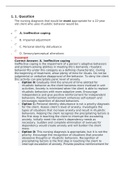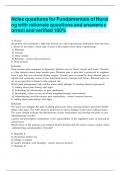Exam (elaborations)
Practice Questions Nursing Test Bank, (10) Personality and Mood Disorders NCLEX Practice Quiz #10- 110 Questions
- Course
- Institution
mental health and psychiatric nursing, mental health and psychiatric nursing nclex practice questions, mental health and psychiatric nursing book, mental health and psychiatric nursing pdf, mental health and psychiatric nursing r sreevani pdf download, mental health and psychiatric nursing question...
[Show more]












